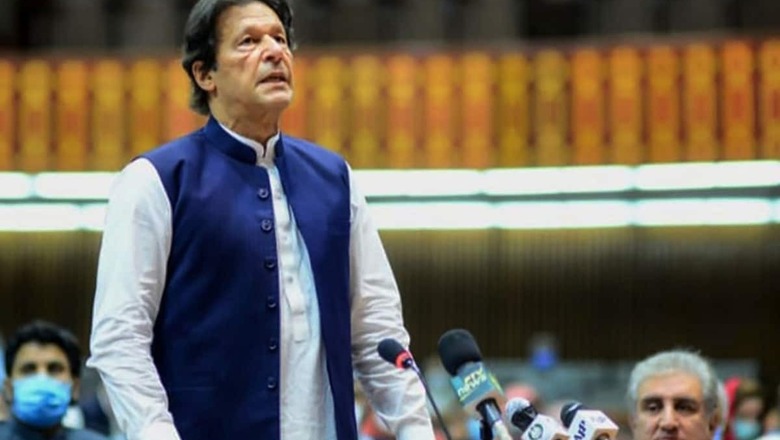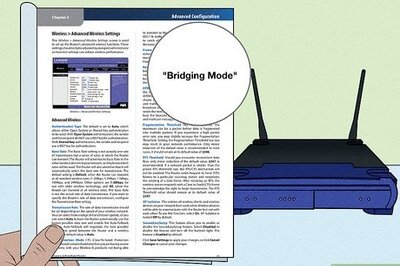
views
The civilian government in Pakistan led by Prime Minister Imran Khan gave in to the demands of radical outfit, Tehreek-e-Labbaik-Pakistan (TLP), which the country designated as a terrorist organisation and banned just last week, to pass a resolution in its National Assembly to remove the French Ambassador.
Both PM Khan could not have taken this decision without discussing with the Pakistan army and its chief Qamar Javed Bajwa, to yield to the demands of an entity that they proscribed after arresting its leader on April 12.
Recently, the country has seen violent protests by the TLP protesters, who have openly challenged the authorities, across the country. They are protesting against French President Emmanuel Macron’s defence of Charlies Hebdo magazine over the rights to publish Prophet Mohammad’s cartoons.
French goods were boycotted and the group led a siege to Pakistan’s capital Islamabad in November. An assailant, inspired by late TLP leader Khadim Rizvi, stabbed two people in Paris in September, outside the office of Charlie Hebdo. Pakistan’s government was forced to agree to the demand to remove the French Ambassador from the country and the recent phase of violence was a warning to the government of Pakistan and the army to do what it agreed to do.
Pakistan army keeps a tight hold on the foreign policy matters of the country and ousting an ambassador will certainly need its approval.
The current phase of violence by TLP protesters has killed six police officers, took 11 police officers as hostages and injured more than 800 as per different news reports from Pakistan. The whole of Pakistan and the world saw how the police officers taken hostage were shown on social media for a week but the government of Pakistan could not do anything. They were released by TLP only after the government backtracked and came back on the dialogue table.
But what is a bigger warning here for Pakistan’s government and its army here is the fact that TLP is now being supported by Pakistan’s largest terror group Tehrik-e-Taliban Pakistan (TTP) which has so far opposed outfits like TLP for not being too hardliner when it comes to religious motivation.
When a Barelvi movement outfit like TLP which, so far had practiced a degree of religious tolerance, but now shows a radical and fundamentalist overture and gets support from TTP, a militant group, it shows the ruling establishment in Pakistan is expected to see more trouble in future with radical and militant outfits coming together.
That, naturally raise the question that what has happened to a military state.
Pakistan has always been military state since it was first military coup in 1950s. The country has been ruled by its army chiefs have directly for over 35 years and indirectly ever since 1954. That year, Pakistan’s army pushed the country to dissolve the Pakistan’s Constituent Assembly, which was drafting its constitution. Whenever, under international pressure, a civilian government was installed, it was always driven by the commands of the Pakistan military.
Whenever the heads of civilian governments tried to make the civilian ruling arrangement the core point of Pakistan’s constitutional identity, they faced wrath of the Pakistani army chiefs. Whenever they saw differences with the civilian government increasing or an ambitious civilian leader at the top, the only solution was a military coup, be it Zulfiqar Ali Bhutto or Nawaz Sharif or other heads of the different civilian governments in Pakistan.
Prime Minister Zulfiqar’s government was first removed in 1977 on allegations of vote rigging, then he was hanged to death by then Pakistan army chief Zia ul-Haq who later on ran Pakistan for 11 years till he died in air crash in August 1988.
Nawaz Sharif faced Pakistan army wrath twice. First in October 1999, when he was ousted from the power corridors by General Parvez Musharraf who ruled Pakistan for next nine years. Pakistan army never liked Nawaz Sharif’s handling of foreign affairs, especially with India.
Then again in 2017. Pakistan’s army pushed the Pakistan’s supreme court to disqualify Nawaz Sharif after graft charges against him in the Panama papers scandal and to declare him a proclaimed offender for not disclosing UAE Dirhams 10,000 in his 2013 election nomination papers, while, in reality, Sharif never received this money.
The current prime minister of the Pakistan Imran Khan has no such big dreams. He, in fact, is known as Pakistan army chief Qamar Javed Bajwa’s ‘yes man’.
Pakistan’s military dictators saw jihadi culture as a state tool to destabilize the immediate neighborhoods in India and Afghanistan to secure geostrategic goals. It began in 1980s when Pakistan gave rise to Mujahideens or religious fighters, who engaged in what they called Jihad . Mujahideens were Afghan tribal warlords who fought against USSR in Afghanistan. The second breed of terrorists in Pakistan were those who were to work against India and especially against the Indian state of Jammu & Kashmir.
Pakistan, in a way, created two safe havens for these terrorists. One was supported by CIA-NATO to wage war against USSR in Afghanistan while the other was funded and trained by Pakistan army and ISI, Pakistan’s intelligence agency.
Not realizing that this safe haven culture was going to haunt it in future.
After the collapse of the Soviet Union and end of war against USSR in Afghanistan, these countless Mujahideens were a jobless fraternity. Religiously motivated, Pakistan saw in them the birth of Taliban. The army needed a favourable government in Kabul to get upper hand in the dispute over the Durand Line, the border line between Pakistan and Afghanistan and got it with Taliban establishing its rule over Afghanistan in 1996.
Till 2001, these two terror havens in Pakistan gave Pakistan good returns, until 9/11 happened.
9/11 was planned by Al Qaeda in Afghanistan and America warned Musharraf to join the war against terror and remove the Taliban government and wipe-out the Al Qaeda network. Pakistan was in no situation to say no, even if it chose to adopt an evasive culture later on.
The move by Pakistan started a vicious circle. The safe terror haven policy it used for its own interests in Afghanistan created deadly terror beasts later that would later challenge its authority.
The Deadly Groups
According to a terrorism database website SATP, Pakistan has 81 proscribed terrorist groups of which 45 are currently active. These include terror groups working against India like Hijbul Mujahideen or Lashkar—e-Taiba or Jaish-e-Muhammad or Tehrik-e-Taliban Pakistan (TTP) or the Haqqani Network, which trace their origin to Afghanistan or Al Qaeda which is working closely with TTP.
According to the Center for International Security and Cooperation (CISAC), TTP is the largest terror group in Pakistan. It has reunited many terrorist groups along the Afghanistan-Pakistan border under the Pakistani Taliban banner.
Pakistan’s own action gave rise to this deadly beast even if tried to resettle Taliban, Al Qaeda and Haqqani leadership secretly inside Pakistan. Under pressure, Pakistan was conducting operations to find out and hunt terrorists fleeing from Afghanistan to border areas in Pakistan. Pakistan had no influence in Federally Administered Tribal Areas (FATA) and the dominant tribal communities of the area saw it as an attack by the State of Pakistan.
The result, they gave rise to TTP in 2007. TTP sought to establish its own authority in the region bordering Afghanistan. It waged a war against the State of Pakistan and Pakistan army and the religious motivation of its Sunni terrorists have seen countless killing so far in Pakistan, be it soft-liner Sunni Muslims or attacks on minorities like Shias or Christians.
TTP, according to some estimates, has over 6000 terrorists or jihadi members. The organization, apart from targeting Pakistani areas, also carries regular cross-border attacks in Afghanistan and as per an UN estimate, has reunified many splinter groups in Afghanistan that may be a security nightmare for Pakistan and Afghanistan in future.
And now with the TLP move, it is taking the same course in Pakistan. Aligning with different terror groups and radical outfits there. More jihadis come together. Increasing its hold onto a larger extent in Pakistan will help achieve dual objectives. First, it will get more arsenal to challenge the ruling authorities in Pakistan including its army. Second, it will get access to a larger area, that means more chances to recruit terrorists that it will now need as the U.S has announced to withdraw its troops from Afghanistan in September 2021.
This jihadi terrorism killed 8,832 military and police officials and 23,372 civilians between March 2003 and October 2018 says a report by the Brown University and the failure of handling the jihadi outfits like TLP only indicates that crisis may go deeper in future.
Read all the Latest News, Breaking News and Coronavirus News here. Follow us on Facebook, Twitter and Telegram.




















Comments
0 comment